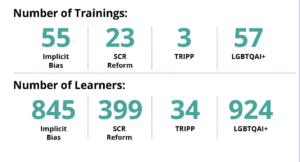CARES/FAR
The Collaborative Assessment, Response, Engagement and Support (CARES) strategy, also known as Family Assessment Response (FAR), is an alternative to the investigative track for reviewing reports of child abuse and neglect available to families when there is no immediate or impending danger to children.
Families who take part in CARES, collaborate with Child Protective Specialists (CPS) to address problems that could affect child safety. “It’s really about partnership and engagement with the families,” said Maria Gomez, CARES Lead Coach for the Workforce Institute. “So, families and child protective specialists can assess together … the areas of strength as well as the areas of need. And if there are areas of need, what are the family’s solution to those?”
 It was the collaborative nature of CARES that Jill Campbell found particularly impactful as a CARES/FAR CPS. “A lot of times families may have strengths, but it may not be seen because of the type of questions we’re asking or because we’re always telling them what to do,” said Campbell. “But actually, having a conversation with families and identifying what the family is capable of doing really helps them with their self-esteem.”
It was the collaborative nature of CARES that Jill Campbell found particularly impactful as a CARES/FAR CPS. “A lot of times families may have strengths, but it may not be seen because of the type of questions we’re asking or because we’re always telling them what to do,” said Campbell. “But actually, having a conversation with families and identifying what the family is capable of doing really helps them with their self-esteem.”
Maria describes the feedback from learners as overwhelmingly positive. “All of the responses have been, ‘I wish I had CARES sooner; I wish I had CARES when I was a CPS; This is what I signed up for.’”
TRIPP Training of Trainers
In FY22, the Workforce Institute began training provider agencies to deliver the Trauma Responsive and Informed Parenting Program (TRIPP), a learning program that provides foster parents and Child Welfare professionals with a new understanding of the challenging behaviors they may encounter with the children and youths in Therapeutic Family Foster Care. Learners explore the impact of trauma, as well as the lasting effects on an individual that stem from an event, series of events, or circumstances that caused the individual physical or emotional harm. Additionally, learners are taught strategies to de-escalate behavior and practice emotionally responsive parenting.
Batsheva Berger, an Ohel Children’s Home and Family Services facilitator with over 16 years of experience, hopes TRIPP will provide learners with a deeper appreciation for how trauma impacts a child. “Every behavior that comes out of that trauma needs to be looked at and evaluated differently from their own children who have not had trauma. They may display the same behavior, but it has to be managed in completely different ways,” says Berger.
SCR Reform
In Fiscal Year 2022, the Workforce Institute launched two trainings (SCR Reform Bill: Promoting Equity Through Legislative Change and Applying SCR Reform to Your Daily Practice: Information Gathering and Documentation), both aimed at preparing Child Welfare staff for changes in Statewide Central Register (SCR) legislation that would go into effect at the start of the year. Maintained by the New York State Office of Children and Family Services, the SCR receives and documents reports of alleged child abuse or neglect. If evidence is found that the allegations are true, the report is considered “indicated”, which can prevent parents from working with children, becoming foster parents, adopting, or maintaining custody of their children. The reforms were enacted to bring more equity to the child welfare system and promote the safety of New York City’s children, while preventing some of the collateral consequences of having an indicated case. Additionally, these changes help reduce the racial disproportionality found in the child welfare system by raising the standards for indicating a case. No longer can a case be indicated with some credible evidence. Case workers must find a fair preponderance of evidence — evidence that outweighs the evidence that is offered to oppose it.
“Most of the families we work with in NYC [are] based off of themes of race and racism and bias that we see that were created in the child welfare system,” says Workforce Institute Senior Facilitator, Daniel Siford. “So, if your standard is so low to indicate a case, then you can just indicate a case because its worthy and capable of being believed. This makes workers dive a little bit deeper and work a little bit harder… so we don’t see any undue hardships for the families that we work with.”
LGBTQAI+ Youth
 In the course Include, Empower, Affirm: Policy, Best Practices and Guidance for Serving LGBTQAI+ Children and Youth Involved in the Child Welfare and Juvenile Justice System, learners explore ways to promote the safety, permanency and well-being of LGTBQAI+ youth. Attendees practice creating affirming environments where all are respected.
In the course Include, Empower, Affirm: Policy, Best Practices and Guidance for Serving LGBTQAI+ Children and Youth Involved in the Child Welfare and Juvenile Justice System, learners explore ways to promote the safety, permanency and well-being of LGTBQAI+ youth. Attendees practice creating affirming environments where all are respected.
Workforce Institute Learning Practitioner Pharon Ford credits the trainings with helping to create empathy and understanding by putting learners in the shoes of young people. “Really what I love to see are when folks have their own ah-ha moment and are vulnerable enough to say, ‘I didn’t hit that mark, I didn’t get it right, or I wish I wouldn’t have done that, but I’m here,’ and then become not just an ally, but one of the change agents that make the shift in culture,” says Ford.
SCR Reform
In FY22, the Workforce Institute launched two trainings (SCR Reform Bill: Promoting Equity Through Legislative Change and Applying SCR Reform to Your Daily Practice: Information Gathering and Documentation), aimed at preparing Child Welfare staff for changes in Statewide Central Register (SCR) legislation, enacted to more equity to the child welfare system. These changes help reduce racial disproportionality in the child welfare system by raising the standards for indicating a case. No longer can a case be indicated with some credible evidence. Case workers must find a fair preponderance of evidence — evidence that outweighs the evidence that is offered to oppose it.
“Due to themes of race, racism and bias ingrained in the NYC child welfare system, we work mainly with families of color,” says Workforce Institute Senior Facilitator, Daniel Siford. “So, a higher standard to indicate a case makes workers dive deeper and work harder in order to ensure the families we work with don’t experience any undue hardships.”
Understanding & Undoing Implicit Bias
Understanding & Undoing Implicit Bias helps learners recognize and understand how biases contribute to racial disproportionality in the Child Welfare and Juvenile Justice systems. As one of ACS’s racial equity strategies, learners practice strategies that reduce the implicit bias in their work and enhance their equitable decision-making.
One topic covered during the training is the importance of words. “If I’m the first person [to investigate a family] and my documentation doesn’t identify the family’s strengths and uses language that is leading, the next person to read my notes will be filled with biases,” says Consultant/Senior Facilitator, Patricia Taylor.
Although the work can be challenging it can also be rewarding. “There are moments where people will say, ‘I’m embarrassed to say I grew up being told ABC and now through my education [and] my exposure, I know better.’ When people have those self-epiphanies it’s just a beautiful thing to be a part of,” says Taylor.






